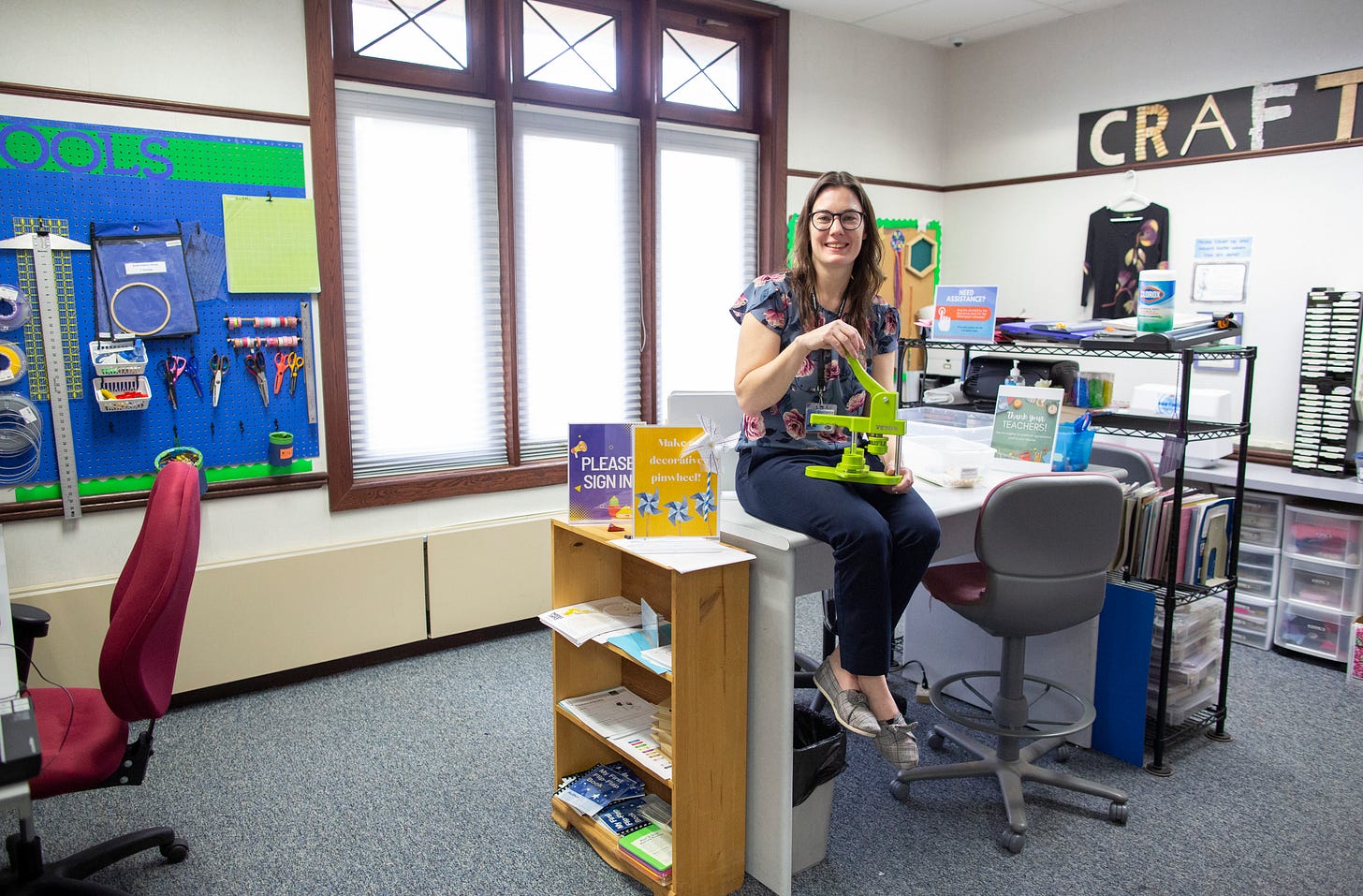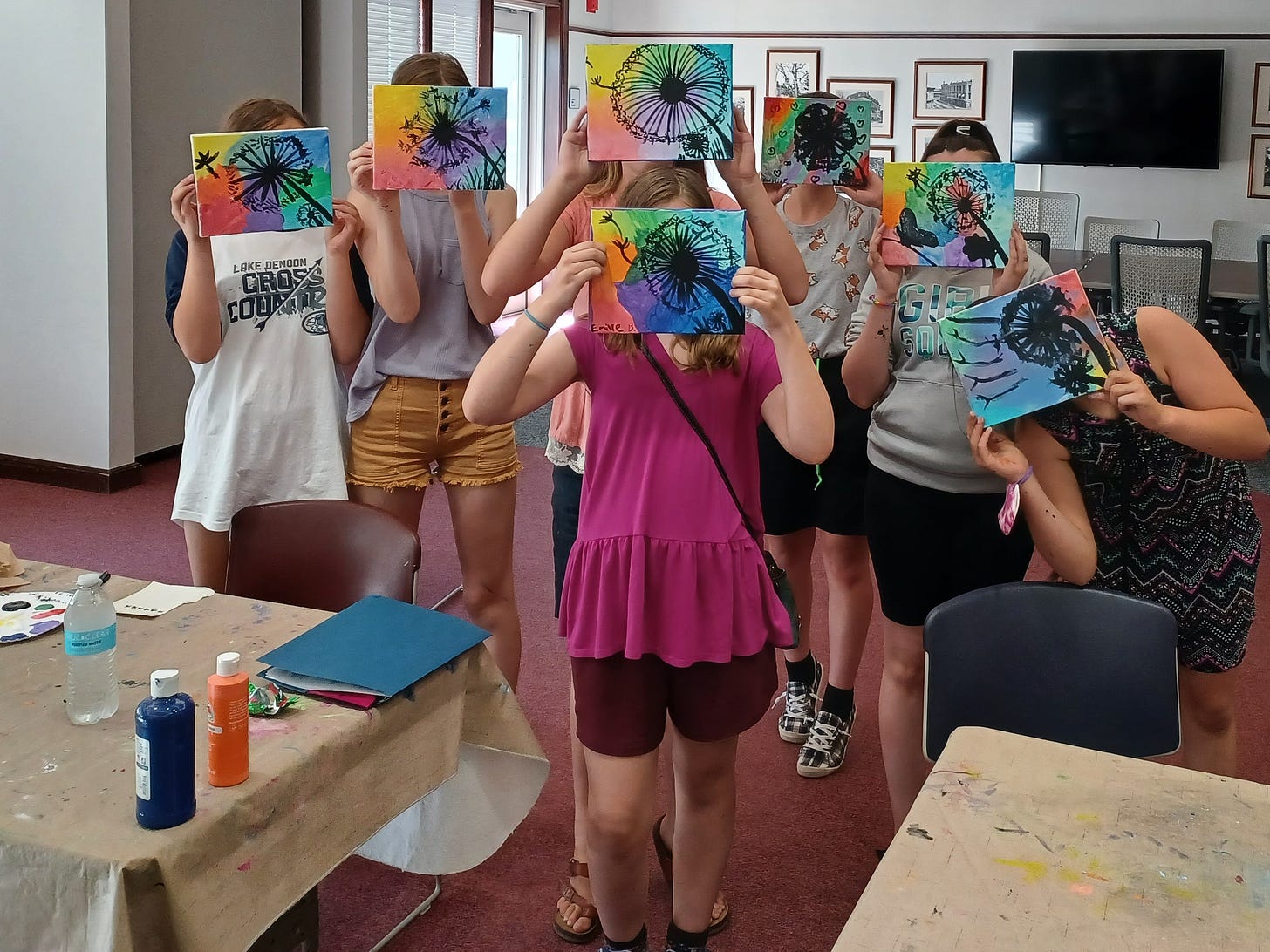Connecting & facilitating in Whitewater, Wisconsin
WorkshopTalk with Sarah French, Programming & Makerspace Librarian at the Irvin L. Young Memorial Library (Whitewater WI). Plus, a spotlight on the Community of Literary Magazines & Publishers.
A note from the IArtLibraries team: We’ll be taking a break from project work mid-December through mid-January, so our newsletter and email will go quiet for a little while. We look forward to seeing y’all and picking up the conversation in the new year.
Introduction
In library lifespans, the makerspace at Irvin L. Young Memorial Library has been around for a long time: twelve years. Now that space is getting a refresh thanks to a building expansion project which will create a flexible footprint that can expand and contract to accommodate small and large groups, and will finally include a sink, kitchen, and that thing that library community spaces can rarely seem to find enough of: storage space. That space is vital because in Whitewater, Wisconsin, the library and its makerspace coordinator, Sarah French, are busy.
A blank, full-time slate
While the library’s makerspace has existed for a relatively long time, it took a while for the library to determine – and fund – a staffing model to support the community’s use of the makerspace. The role of Programming and Makerspace Librarian grew from a part-time to a full-time position just as the pandemic hit in 2020. The person hired initially soon left to take a position closer to home, leaving an opportunity for Sarah French, a working artist with lots of programming experience in libraries, to step into a role that unites her creativity and her love for human connection.
Understanding the landscape first
With the pandemic still in full swing, Sarah had the time, space, and permission from her director to basically build her position and the makerspace platform from scratch. As someone new to Whitewater, a community of 14,000 that includes a small university campus, Sarah took her time to survey the local landscape to understand what creative spaces and communities looked like already. Through that work, she discovered opportunities for the library to contribute to Whitewater’s wider creative landscape, rather than competing with it. The makerspace’s cyclical rhythm now includes the following:
For school-age kids, one monthly maker program, and one take-and-make kit. “This is a busy, involved community,” Sarah says, and having grab-and-go options help ensure that creative offerings fit easily into community members’ lives.
The makerspace offers one teen program per month.
For adults, there are one or two events offered per month. One is a maker program, one is a collaborative program featuring an outside presenter or library partner.
Upcoming in 2023 is a monthly “Little Makers” program, which offers process art projects for kids ages 2-5.
Sarah’s day to day in-person work includes event and workshop prep and hosting, and then being a host welcoming people to the makerspace. She helps people learn how to use the makerspace equipment. People can sign up to learn how to use the library’s 3D printer, sewing machine, Cricut maker, and the “memory lab,” where people can convert VHS tapes and other formats to digital. That equipment in particular is, Sarah notes, very popular with older adults, creating a gateway for people to discover what else is on offer in the space.
Speaking of storage space, Sarah installed a “finder binder” at the library’s front desk and in the makerspace. The binder has graphic illustrations of tools and equipment that aren’t out or on display.
One aspect of the space Sarah works hard to cultivate is a feeling of discovery and inspiration through process, rather than guiding people through strict instructions to a particular product. “Kids will dig through the drawers and explore, [and] use the discard bin to find materials for sculptures,” but she’s constantly working to convince adults in particular that they have permission to experiment. “This space is FOR everyone, welcoming of everyone. I have to remind myself that people might not know what ‘makerspace’ even means.” She enacts this through self-directed project stations or prompts for people to work on, such as Inktober challenges in October.

Communities of practice
With the building expansion and a new makerspace on the horizon, Sarah notes that she’s been looking to larger libraries for inspiration. There’s also a clutch of librarians with similar titles and roles among the libraries in Whitewater’s library system that meets to swap ideas and best practices. This sub-community of nearby makerspace librarians is important to her, as the role “can feel isolating. You’re typically the only person in the building working on this.” Luckily, there’s also a strong creative community close by, which Sarah is regularly participating in by having ongoing conversations and just being present at gatherings and on boards. Her focus at the moment is exploring how to work more closely with folks at the university and with the Whitewater Arts Alliance, a local non-profit arts organization.
Connection and facilitation
Sarah is keenly aware that she’s one person coordinating a lot of moving parts, which is why she embraces the role of “connector and facilitator” rather than instructor or in-house programmer. In that role, “you can do more, you can offer more things.” Targeted, strategic collaborations are key, and it ends up being a win-win: it’s ultimately a time saver for her, it strengthens community connections, and is a way the library can welcome people who might not be library users currently. When asked about her advice for others working in similar positions, Sarah encourages people to set boundaries and try not to take on too much. She notes that she’s a working artist herself, with family and school besides work (she’s on track to finish her MLIS soon). When patrons or potential partners reach out with something new, she’s okay with pacing herself to have a conversation and revisit new ideas down the road.
When I ask her about a specific story that she feels exemplifies the makerspace “in action,” she tells a story about a fourteen-year-old patron who came in looking for advice about sewing. Sarah “showed her the library’s sewing section, and the sewing machine we have in the makerspace. As we were chatting, [the patron] shared that she wanted to learn sewing to support her cosplay.” Sarah gave her her card, and suggested that if the patron was interested, she could host a library event for other young people. This came to fruit with a youth-led slate of events that focused on Dungeons & Dragons, fan fiction, and fandoms – something far outside of Sarah’s own wheelhouse. The patron was able to fulfill needed volunteer hours for high school, and Sarah wrote her a letter of recommendation. This story showcases not only the makerspace in action, but the effectiveness of Sarah’s approach to working alongside the community – having low-pressure conversations and asking follow-up questions to understand peoples’ interests and skill sets.
Library work is creative work
Sarah counts herself among the many who identify as artist-librarians; her most frequent medium is embroidery. She grapples with the fact that her day job may take time away from her art-making practice, though she does find opportunities to exercise creatively at work – she handles much of the library’s graphic design projects, for example. “Embroidery is a slow, meditative process. I’m working on big pieces and have a good outline or structure, but literally, each stitch takes a long time, it’s very mindful.” For her personal work, her time horizon is extended – five years or more for her current pieces. She is happy that she found library work, work with a broader social mission with creativity permeating it.
IArtLink of the Month
The Community of Literary Magazines and Presses (CLMP) “are hundreds of small publishers creating print and digital books, magazines, online publications, chapbooks and zines, who have come together to do our work as publishers better and to organize around a shared set of beliefs.” To learn more about CLMP and to dive into the diverse, rich world of independent publishing, start at their About page and consider subscribing to their newsletter which you can do right from their homepage.



